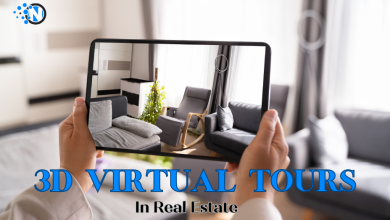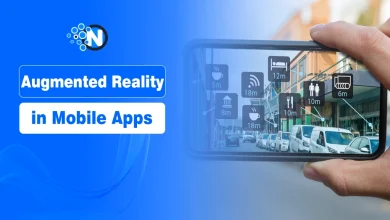Augmented Reality and Its Potential for Businesses
A few months ago, I was shopping for a new couch online. You know the struggle – trying to guess if the color will match your walls or if it’ll even fit in your living room. Then I stumbled upon an app that let me place a virtual version of the couch right in my space using Augmented Reality (AR). I could walk around it, see how it looked from different angles, and even swap colors with a tap. It felt like magic!
AR is transforming how we purchase, study, and do business, not simply a futuristic fad. From putting on clothing without entering a fitting room to envisioning a new office layout before relocating a desk, AR is changing industries in ways we never anticipated. How can firms use this changing technology? Let’s know AR’s unlimited business potential.
Understanding the Augmented Reality
Augmented reality, or AR, is an emerging technology that adds computer-generated images and information on an individual’s natural surroundings to enhance everything with multiple instruments. The retail sector, production, advertising, health care, and perhaps even tourism may all profit from technology.
Augmented reality (AR) in retail allows customers to virtually try on clothing and arrange furniture before purchasing, increasing engagement and sales. (AR) increases production output by giving workers real-time guidance and instructions. Marketers use augmented reality for engaging campaigns to boost brand awareness. Virtual and interactive mobile apps are two ways it improves the travel industry.
Key Stats to Know About
⭐Retail and E-Commerce: The mobile AR market was valued at $11.9 billion in 2024 and is projected to reach $13.8 billion in 2025. (Statista, 2024)
⭐Manufacturing and Maintenance: The integration of AR in manufacturing and the Internet of Things (IoT) is expected to generate an economic value between $40 and $50 billion by 2025. (Learn G2, 2024)
⭐Marketing and Advertising: When compared to non-AR encounters, augmented reality product experiences are 200% more engaging and interactive. (Learn G2, 2024)
⭐Tourism and Hospitality: There is a lot of room for growth in the augmented reality market, which is expected to reach $1,869.40 billion by 2032 from $93.67 billion in 2024. (Fortune Business Insights, 2025)
⭐Healthcare and Medical Training: The AR/VR market in the global healthcare industry is estimated to reach $10.82 billion by 2025, with a CAGR of 36.1%. (MeetAnshi, 2025)
Applications of Augmented Reality in Businesses
Retail, manufacturing, marketing, healthcare, tourism, and education are key areas where businesses can utilize augmented reality.

1. Retail and E-Commerce
Augmented reality (AR) has completely transformed customer service in brick-and-mortar stores and online marketplaces. Customers can virtually try on clothing, accessories, or makeup before purchasing because of its ability to power virtual try-on experiences.
It also helps clients imagine how furniture would look in their homes by allowing them to arrange items in their rooms virtually. Using AR in retail apps creates a more engaging and immersive experience for the shopper, boosting app sales.
2. Manufacturing and Maintenance
The use of augmented reality (AR) has had a profound effect on both production and upkeep. AR enhances precision, efficiency, and output by superimposing digital instructions on real-world objects in real time.
With all the relevant data and instructions right before them, workers can complete assembly and maintenance jobs more quickly and with fewer mistakes. With AR-powered training modules, employees can experience immersive learning without needing physical equipment to practice procedures and obtain hands-on knowledge.
3. Marketing and Advertising
The application of augmented reality (AR) has changed the marketing and promotional industries. The advertisements allowed by AR, can be created by brands and allow people to engage with virtual products, characters, and branded content.
Using a user’s location, preferences, and past actions, virtual reality (AR) offers highly customized marketing campaigns. Marketers can differentiate themselves in the crowded digital space using AR and design campaigns that leave an imprint on customers, strengthening their commitment to the brand.
4. Tourism and Hospitality
Major developments will be implemented in tourism and the hospitality industry as an outcome of virtual reality (AR). Virtual tours, historical context, and real-time directions contribute to a more fulfilling trip for users. Guests may take a virtual look around the hotel, see what’s available, and get some recommendations thanks to AR technology.
When combined with the data gathered from hotel AI technology, hotels can make recommendations based on each guest’s preferences, further enhancing their experience
Businesses in the travel and hospitality industries can better entice clients to explore new areas by incorporating AR technology so that they can have more interactive and immersive experiences while doing so.
5. Healthcare and Medical Training
Augmented reality (AR) has been a game-changer in healthcare and medical education. Surgeons can benefit from AR by superimposing patient data, medical pictures, and real-time guidance during intricate surgeries. Medical students can benefit from AR’s simulated training scenarios, which help them develop their skills and retain more information.
Helpful diagnostic and treatment guidelines are available in real-time to medical professionals. Further, AR helps make telemedicine a reality by opening up the possibility of remote consultations and advice.
Benefits of Augmented Reality for Businesses
Improved customer interaction, more sales, fewer wasted hours in training, more effective learning, and a leg up on the competition: are just some of how augmented reality (AR) helps businesses thrive.
1. Enhanced Customer Engagement
AR boost customer involvement because of the engaging and immersive experiences it offers. Customers can imagine the product or service in their setting, leading to a more relevant and interesting encounter.
Augmented reality (AR) allows for engaging virtual try-on experiences, interactive product demos, and immersive virtual tours, all keeping clients engaged and interested.
2. Improved Sales and Conversions
The fact is established that augmented reality (AR) technology boosts a company’s bottom line. Furthermore, AR offers interactive product demonstrations, allowing clients to virtually try things before purchasing. Integrating AR into sales and marketing strategies enhances customer happiness and trust, increasing sales performance and conversion rate.
3. Cost and Time Savings
Businesses can conserve money and time with AR technology. Professionals can now provide remote advice and assistance with augmented reality, cutting down on travel expenditures and improving operational efficiency. This means goodbye to expensive and time-consuming on-site visits.
Training duration and expense can be cut dramatically with the help of augmented reality-based instructional modules.
4. Enhanced Training and Learning
Business training and education can benefit greatly from augmented reality (AR). This technology assists pupils master tough activities and achieve better in school by offering rapid feedback and teaching. AR has the potential to upskill workers, boost employee competence, and propel company success through improving training and learning outcomes.
Challenges and Considerations in AR
Despite its vast potential, AR comes with challenges that businesses must address before implementation.
1. Technological Limitations
Although it has great potential, augmented reality (AR) is now constrained by technical hurdles. Excellent graphics, precise tracking, and dynamic interfaces are required to create smooth and realistic AR experiences, all of which can be difficult to produce. Smartphones and smart glasses are examples of hardware that could limit AR’s potential
2. User Adoption
Although augmented reality’s (AR) potential is vast, gaining widespread user acceptance may not be easy. The adoption and use of its applications may be slowed if some users find them too complicated or new.
Accessibility can also be hindered for some users due to the necessity for specialized hardware or equipment. Organizations should prioritize user-friendly interface design, comprehensive documentation, and responsive customer service to increase uptake.
3. Privacy and Security Concerns
Augmented reality (AR) usage presents ethical and safety questions. Potential security issues arise because it depends on user data and real-time tracking.
- Protecting private data during AR interactions requires the use of encrypted channels of communication.
- Suppose businesses want to earn their customers’ trust and lessen the likelihood that their personal information will be misused.
4. Cost of Implementation
Companies should be willing to spend heavily on introducing augmented reality (AR) technological advances.
- Purchases of AR-enabled gear, like a smartphone, tablet, or smart glasses, are included in this category of expenses.
- AR into preexisting systems and training staff to use it efficiently are potential expenses. Before committing to using AR, organizations must thoroughly assess the ROI and consider its viability over time.
Conclusion
Ultimately, the mixed reality (AR) perspective is huge for businesses in various sectors. Its value has been proven in numerous fields, such as commerce, industry, advertisement, health care, tourism, and education. AR enhances training and instruction outcomes, increases sales and changes, reduces activities, and improves customer loyalty.
However, organizations also need to consider the expense of implementation, the obstacles to user uptake, the need to protect users’ privacy and security, and the constraints of available technology. The dynamic and ever-changing business landscape can be navigated with the help of augmented reality (AR) if companies consider the factors mentioned above.





